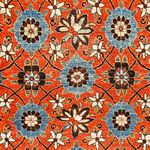Difference between revisions of "WikiRug:Featured Article/2020/32"
Jump to navigation
Jump to search
(Created page with "|right|150px Varamin rugs are categorized in the trade under two time periods, the last quarter of the nineteenth c...") |
|||
| Line 1: | Line 1: | ||
[[File:Varamin-Rugs-Rugman-Collection.jpg||right|150px]] | [[File:Varamin-Rugs-Rugman-Collection.jpg||right|150px]] | ||
| − | [[Varamin Rug|Varamin rugs]] are categorized in the trade under two time periods, the last quarter of the nineteenth century and 1920s to the present day. | + | <div style= "font-size:85%;text-align:center;"> |
| + | </div> | ||
| + | |||
| + | [[Varamin Rug|Varamin rugs]] are categorized in the trade under two time periods, the last quarter of the nineteenth century and 1920s to the present day.<br> | ||
Early Varamin rugs were woven by the Shahsavan tribe, which moved south from northwestern Persia and settled in Varamin.These rugs are geometric and sometimes have Minakhani (rosette-linked trellis) motifs with tribal design elements in the field. Other pieces are more strongly geometric, with abstract small medallions and other devices derived from flatwoven mum rugs. The rugs have a wool foundation and a wool pile. The Turkish (symmetric) knot is employed. .('''[[Varamin Rug|Full article...]]''') | Early Varamin rugs were woven by the Shahsavan tribe, which moved south from northwestern Persia and settled in Varamin.These rugs are geometric and sometimes have Minakhani (rosette-linked trellis) motifs with tribal design elements in the field. Other pieces are more strongly geometric, with abstract small medallions and other devices derived from flatwoven mum rugs. The rugs have a wool foundation and a wool pile. The Turkish (symmetric) knot is employed. .('''[[Varamin Rug|Full article...]]''') | ||
Latest revision as of 13:06, 16 December 2020
Varamin rugs are categorized in the trade under two time periods, the last quarter of the nineteenth century and 1920s to the present day.
Early Varamin rugs were woven by the Shahsavan tribe, which moved south from northwestern Persia and settled in Varamin.These rugs are geometric and sometimes have Minakhani (rosette-linked trellis) motifs with tribal design elements in the field. Other pieces are more strongly geometric, with abstract small medallions and other devices derived from flatwoven mum rugs. The rugs have a wool foundation and a wool pile. The Turkish (symmetric) knot is employed. .(Full article...)
